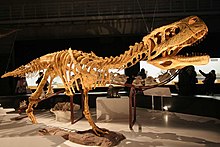Abelisauroidea
| Abelisaurs Temporal range: Middle Jurassic - Late Cretaceous,
| |
|---|---|

| |
| Reconstructed skeleton of Aucasaurus garridoi | |
| Scientific classification | |
| Domain: | Eukaryota |
| Kingdom: | Animalia |
| Phylum: | Chordata |
| Clade: | Dinosauria |
| Clade: | Saurischia |
| Clade: | Theropoda |
| Clade: | †Neoceratosauria |
| Superfamily: | †Abelisauroidea Bonaparte & Novas, 1985 |
| Clade: | †Abelisauria Novas, 1992 |
| Families | |
Abelisaurs (Abelisauria or Abelisauroidea) were a group of ceratosaurian dinosaurs. Some well-known dinosaurs of this group include the abelisaurids Abelisaurus, Carnotaurus, and Majungasaurus.
Abelisaurs flourished in the Southern hemisphere during the Cretaceous period, but their origins can be traced back to at least the Middle Jurassic, when they had a more global distribution (the earliest known abelisaur remains come from Australian and South American deposits dated to about 170 million years ago).[1] By the Cretaceous period, abelisaurs had apparently become extinct in Asia and North America, possibly due to competition from tyrannosaurs. However, advanced abelisaurs of the family Abelisauridae persisted in the southern continents until the Cretaceous–Paleogene extinction event 66 million years ago.[2]
Classification
- Superfamily Abelisauroidea
- Berberosaurus
- Betasuchus
- Eoabelisaurus
- Ozraptor
- Node Abelisauria[3]
- Family Noasauridae
- Family Abelisauridae
References
- ^ David B. Weishampel (2004-11-06). The Dinosauria: Second Edition. University of California Press. p. 109. ISBN 978-0-520-24209-8.
{{cite book}}: Unknown parameter|coauthors=ignored (|author=suggested) (help) - ^ Martín D. Ezcurra, M.D. and Agnolín, F.L. (2012). "An abelisauroid dinosaur from the Middle Jurassic of Laurasia and its implications on theropod palaeobiogeography and evolution." Proceedings of the Geologists' Association, (advance online publication).
- ^ Tortosa, Thierry (2013). "A new abelisaurid dinosaur from the Late Cretaceous of southern France: Palaeobiogeographical implications". Annales de Paléontologie (In press). doi:10.1016/j.annpal.2013.10.003. Retrieved 13 December 2013.
{{cite journal}}: Unknown parameter|coauthors=ignored (|author=suggested) (help)
